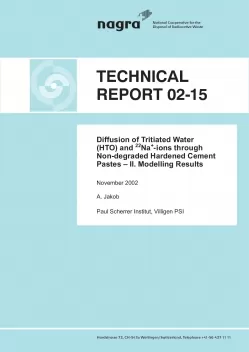
Technical Report NTB 02-15
Diffusion of Tritiated Water (HTO) and 22Na+-ions through Non-degraded Hardened Cement Pastes – II. Modelling Results
In this report, the procedure and the results of an inverse modelling study on the through-diffusion of tritiated water (HTO) and 22Na+-ions are presented using highporous hardened cement pastes with a water/cement ratio of 1.3 in the first stage of the cement degradation.
For the analysis two alternative models were applied: 1) a diffusion model where a possible sorption of the tracer was entirely neglected, and 2) a diffusion model with linear sorption. The analysis of the through-diffusion phase allowed extracting values for the effective diffusion coefficient (De) and the rock-capacity factor (α).
Both models could fit the breakthrough curves equally well, and also mass-balance considerations did not allow to clearly preferring one of the two competing models to the other. But blind-predictions for tracer out-diffusion using the best-fit parameter values deduced from analysing the former through-diffusion phase gave a clear indication that linear sorption had to be included in the diffusion model.
The extracted Kd values for HTO are in excellent agreement with values from batch sorption experiments and are of the order of 0.8 · 10-3 m3/kg. Those for 22Na+ are of the order of 1.0· 10-3 m3/kg and are by a factor of two larger than values from batch sorption experiments. The values for the effective diffusion coefficients for HTO are of the order of (2-3) · 10-10 m2/s, and those for sodium are roughly by a factor of two smaller than values for HTO.
On the one hand, the observed tracer uptake could only partially be addressed to isotope exchange; the most obvious process which could account for the remaining part of the uptaken tracer mass is diffusion into a second type of porosity, the dead-end pores. On the other hand, the results and conclusions drawn are encouraging for future investigations; therefore no major deficiency concerning the applied equipment and the modelling methodology could be detected. In the report, however, some suggestions for new and improved experiments are made which could shed light on the tracerdeposition mechanisms playing a crucial role in diffusion experiments using cementitious materials.
